
The Great Western Railway (GWR) was a British railway company that linked London with the southwest, west and West Midlands of England and most of Wales. It was founded in 1833, received its enabling Act of Parliament on 31 August 1835 and ran its first trains in 1838 with the initial route completed between London and Bristol in 1841. It was engineered by Isambard Kingdom Brunel, who chose a broad gauge of 7 ft —later slightly widened to 7 ft 1⁄4 in —but, from 1854, a series of amalgamations saw it also operate 4 ft 8+1⁄2 in standard-gauge trains; the last broad-gauge services were operated in 1892.

Great Western Railway (GWR) is a British train operating company owned by FirstGroup that operates the Greater Western passenger railway franchise. It manages 197 stations and its trains call at over 270. GWR operates long-distance inter-city services along the Great Western Main Line to and from the West of England and South Wales, inter-city services from London to the West Country via the Reading–Taunton line, and the Night Riviera sleeper service between London and Penzance. It provides outer-suburban services in West London; commuter services from its London terminus at Paddington to the Thames Valley region, including parts of Berkshire and Buckinghamshire, and Oxfordshire; and regional services throughout the West of England and South Wales to the South coast of England. Great Western Railway provides and maintains the Electrostar Class 387 fleet for Heathrow Express.

The Wessex Main Line is the railway line from Bristol Temple Meads to Southampton Central. Diverging from this route is the Heart of Wessex Line from Westbury to Weymouth. The Wessex Main Line intersects the Reading to Taunton Line at Westbury and the West of England Main Line at Salisbury.
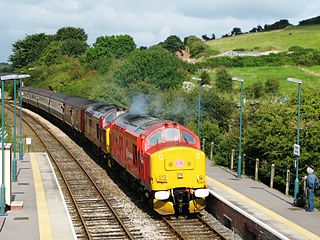
The Heart of Wessex Line, also known as the Bristol to Weymouth Line, is a railway line that runs from Bristol Temple Meads to Westbury and Weymouth in England. It shares the Wessex Main Line as far as Westbury and then follows the course of the Reading to Taunton Line as far as Castle Cary.

Yeovil Pen Mill railway station is one of two stations serving the town of Yeovil, Somerset, England. The station is situated just under a mile to the east of the town centre. The station is located 59.5 miles (96 km) south of Bristol Temple Meads, on the Heart of Wessex Line. The station is managed by Great Western Railway, with trains being operated by them and by South Western Railway.

Salisbury railway station serves the city of Salisbury in Wiltshire, England. It is 83 miles 43 chains (134.4 km) from London Waterloo on the West of England line to Exeter St Davids. This is crossed by the Wessex Main Line from Bristol Temple Meads to Southampton Central. The station is operated and served by South Western Railway (SWR), and is also served by Great Western Railway (GWR).
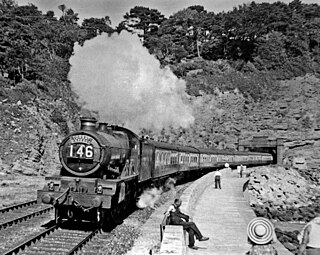
The Torbay Express is a named passenger train operating in the United Kingdom.
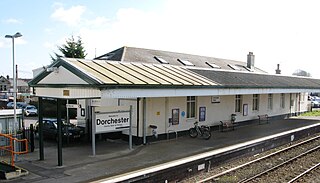
Dorchester West railway station is one of two railway stations serving the town of Dorchester in Dorset, England. The station is managed by Great Western Railway. The station is located on the Heart of Wessex Line between Castle Cary and Weymouth, 161.63 miles from the zero point at London Paddington, and is at the southern end of a single track section from Maiden Newton. The line becomes double at the station and remains so to just before nearby Dorchester Junction, where the line joins the South West Main Line from London Waterloo to Weymouth.
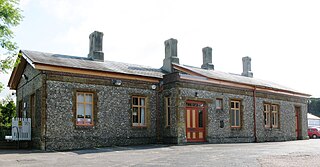
Maiden Newton railway station is a railway station serving the village of Maiden Newton in Dorset, England. The station is located on the Heart of Wessex Line, 154.12 miles from the zero point at London Paddington, measured via Swindon and Westbury.

Westbury railway station serves the town of Westbury in Wiltshire, England. The station is managed by Great Western Railway.
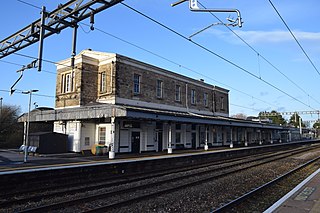
Swindon railway station is on the Great Western Main Line in South West England, serving the town of Swindon, Wiltshire. It is 77 miles 23 chains down the line from the zero point at London Paddington and is situated between Didcot Parkway and Chippenham on the main line. It is managed by Great Western Railway, which also operates all of the services from the station.

Chippenham railway station is on the Great Western Main Line (GWML) in South West England, serving the town of Chippenham, Wiltshire. It is 93 miles 76 chains down the line from the zero point at London Paddington and is situated between Swindon and Bath Spa on the GWML. The Wessex Main Line diverges from the GWML to the southwest of Chippenham and runs to Trowbridge via Melksham.
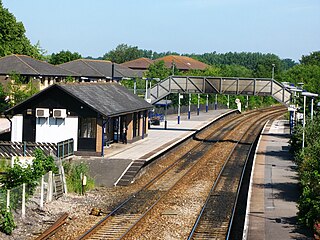
Trowbridge railway station is a railway station on the Wessex Main Line serving the town of Trowbridge in Wiltshire, England. The station is 24 miles (39 km) south east of Bristol Temple Meads and is managed by Great Western Railway.

Thornford railway station serves the village of Thornford, in Dorset, England. It is approximately 3 miles to the south of Yeovil, and 144.35 miles from the zero point at London Paddington. It is managed by Great Western Railway and is served by trains on the Heart of Wessex Line between Bristol Temple Meads and Weymouth.

Melksham railway station serves the town of Melksham in Wiltshire, England. It is 100 miles 13 chains measured from London Paddington, on the TransWilts Line between Chippenham and Trowbridge that was originally part of the Wilts, Somerset and Weymouth Railway, absorbed in 1850 by the Great Western Railway.
The Wilts, Somerset and Weymouth Railway (WS&WR) was an early railway company in south-western England. It obtained Parliamentary powers in 1845 to build a railway from near Chippenham in Wiltshire, southward to Salisbury and Weymouth in Dorset. It opened the first part of the network but found it impossible to raise further money and sold its line to the Great Western Railway (GWR) in 1850.

Go-op is an open access train operating company which is currently proposing to operate a service between Taunton and Swindon, via Westbury. It aims to become the first cooperatively owned train operating company in the United Kingdom, to improve access to the public transport infrastructure through open access rail services linking main lines to smaller market towns, and co-ordinating services with light rail and bus links and car pools.

Holt Junction was a railway station which served the village of Holt, Wiltshire, England between 1861 and 1966. It stood on the Wessex Main Line at its junction with the western end of the Devizes branch.

St Philip's Marsh depot is a railway depot located in the St Philip's Marsh district of Bristol, England. It was established as a steam locomotive shed in 1910 but this facility closed in the 1960s. A new diesel facility opened nearby at Marsh Junction in 1959). This has since been combined with a new shed which was opened in 1976 to maintain new InterCity 125 trainsets.
Lacock Halt was a minor railway station on the Chippenham–Trowbridge section of the former Wilts, Somerset and Weymouth Railway (WSWR), which opened as far as Westbury on 2 September 1848. This connected to the Great Western Main Line at Thingley Junction and was incorporated into the Great Western Railway in March 1850 after the WSWR ran into financial difficulties.



















